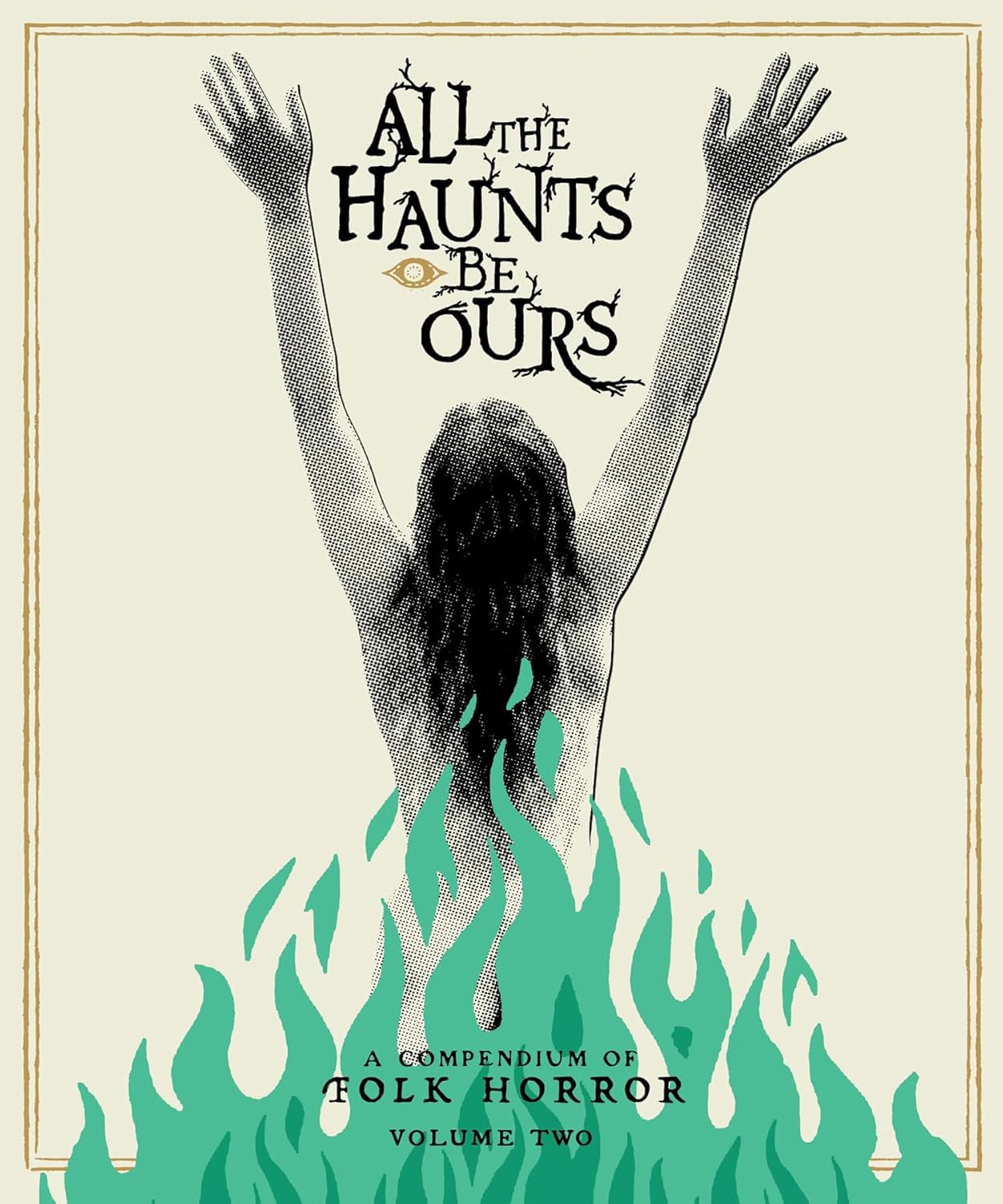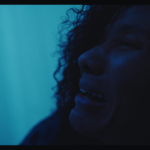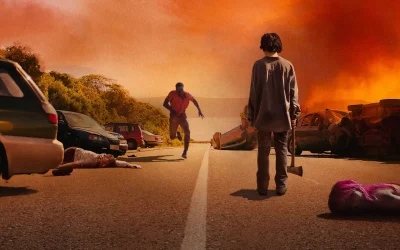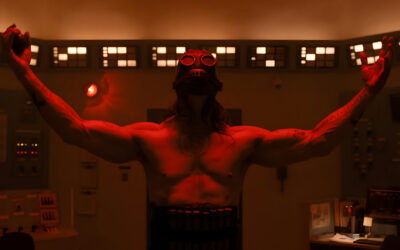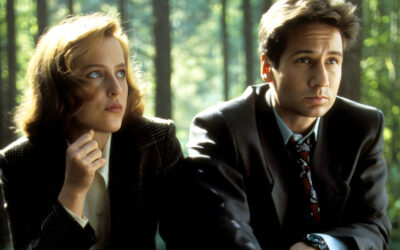A while back, those delightful devils at Severin unleashed a collection of folk horror cinematic yarns titled All The Haunts Be Ours.
I didn’t see it (though you can bet I would’ve reviewed the unholy hell out of it!), but a lot of people must have because here’s All The Haunts Be Ours Vol. 2!
There is a literal monstrous mega-load of material to fix our putrid peepers upon here, so let’s get crackin’ my cats n’ creeps!
First comes 2023’s To Fire You Come At Last…
Back in ye olde 17th century England, a group of men gather to carry the coffin of young Aldis Marlow on the long walk to the nearest cemetery.
On their dour journey, secrets are revealed regarding Aldis’ death… secrets that may provide an open door to the supernatural!
Coming from writer/director Sean Hogan, this moody, black and white (well, 99.9% black and white that is… ) forty-five minute jaunt into the jaws of preternatural dread.
Adding immeasurably to the quality on display is the small ensemble of excellent actors assembled here whom provide top-shelf performances that make the otherworldly happenings believable.
All in all, To Fire You Come At Last is a well acted slice of atmospheric ghoulish goodness and an excellent start to this creepy collection!
Special features included here include an audio commentary courtesy of Hogan and co-producers Paul Goodwin and Nicholas Harwood, afeaturette detailing the actual roads of the dead, a trailer, and a duo of short films; Hogan’s We Always Find Ourselves in the Sea (which also features a commentary track with the folks mentioned previous, and an EPK), and Edwin Rostron’s Our Selves Unknown.
Next up is a personal favorite of yours cruelly, 1973’s Psychomania!
Don Sharp’sbizarre supernatural revenge tale begins with motorcycle gang The Living Dead riding around monolithic witch stones (known as The Seven Witches) in the mist accompanied by fuzzed-out guitar, before causing hooliganism on the highway, and hanging out in a cemetery… which is a recipe for a hit picture right from the jump!
Anyhow, the gang’s leader, Tom (Nicky Henson) returns to the mod digs he shares with his medium mother (Beryl Reid, Entertaining Mr. Sloane) and arcane butler Shadwell (George Sanders, the voice of Shere Khan from Disney’s 1967 adaptation of The Jungle Book in his last role).
Tom is interested in unlocking the secrets of life after death, which a mystic window in his home reveals to be linked to a Faustian contract his mother signed out at the witch stones when our hero was an infant… but also involves frog gods and suicide…
After a day of slapstick assfoolery with the town’s populace and a high speed police chase, Tom pilots his motorcycle off a bridge straight into the arms of death.
Naturally his friends decide to bury Tom (with his mother’s blessing) out at The Seven Witches…sitting atop his mighty bike… and one folk song and a frog-centric amulet provided by Shadwell later, and our haunted (or is it haunting) hero explodes from the ground riding his cycle and full of paranormal power!
It isn’t long before Tom’s resurrection inspires the remainder of The Living Dead, minus the lone hold-out, Tom’s denim dame in a leather world girlfriend Abby (Mary Larkin), to off themselves and ensure their status as undead hell-raisers of the highest order!
Soon Abby will have to face the rest of The Living Dead, as the law closes in and Tom’s mother begins to have second thoughts about her dark deals…
There really is nothing like the experience of Psychomania…
As you can surmise by the sinister synopsis above, this film is as bizarre as they come. Over the course of ninety minutes we get outrageous fashions (did ‘70s biker gangs wear crochet vests… ), zany humor, witchcraft, pacts with ancient evil gods, wonderfully dodgy (not to mention gloriously psychotronic) optical effects, murder… maybe a little sky-diving… none of it should work together, but it absolutely does to surreal, vastly entertaining effect!
The entire affair comes off like a Gold Key horror comic sprinkled with New Age Occultism by way of a Corman produced biker flick and that’s chef’s kiss horror biz goodness through and through!
As before (and going all the way through the remainder of this esoteric assemblage… ) we get some fine supplemental material to enhance our Psychomania appreciation!
Extras here are comprised of an intro to the film courtesy of film historian/filmmaker Chris Alexander, an audio commentary featuring Hellebore magazine Founding Editor Maria J. Pérez Cuervo, a fascinating mini-doc examining the role of stone circles and standing stones in film and TV narratives featuring Dr. Diane A. Rodgers, interviews with actors Henson, Larkin, Denis Gilmore, Roy Holder, & Rocky Taylor, composer John Cameron, and Riding Free (that biker-centric folk dityy mentioned previously) singer Harvey Andrews, and Psychomania’s theatrical trailer!
Movin’ on we come to Disc Two, and 1984’s The Enchanted…
Ex-sailor Royce Hagan (Will Sennett in his only role… who enters the pic looking like… and I shit you not… the spittin’ image of Abel Ferrara in Driller Killer) returns to his now empty family ranch, deep in the Florida backwoods, to settle in as a cattle rancher.
Once there he reunites with family friend Booker T (Julius Harris, Live and Let Die, DeLaurentiis’ remake of King Kong, Sam Raimi’s Darkman)… a man who lives on Royce’s vast, wooded property… a highly superstitious man that has a warning for our hero; to be wary of getting too close to the ultra-strange, loudly dressed, Perdry family… a hard-working clan comprised of a mother, father, two sets of twins, and their eldest daughter Twyla (Casey Blanton… in her only role… a trend that continues for most of the cast… but what they lack in experience they absolutely dominate in the weirdness department… which in turn makes them all very memorable… so A-plus effort there!)… that also lives on Hagan’s land.
Despite that warning, Royce instead hires them to work his property… which begins to worry Booker to no end… but not as much as when he starts a relationship with the innocent Twyla, whom Royce soon moves into his Aunt’s old room.
As time passes, Twyla’s strange behavior indicates that Booker’s beliefs may have merit…
Sprinting from the woods from first-time feature-film director Carter Lord, and first-time screenwriter Charné Porter (who also served as the film’s art director and editor) The Enchanted, a film intended for family viewing (which goes astray from that goal at times), is never anything less than a sort of modern pseudo-fairy tale, and a damn fine one at that…
Featuring beautiful cinematography from Michael Levine (who would go on to work on horror fare such as Christmas Evil and The Dark Half, as well as Pulp Fiction) that truly gives the rural Florida locales the sense of existing on a planet that’s like our own, yet still alien to most viewers… or most given the suitably fever dream editing that occurs from time to time.
Speaking of “dreams”, the only way this would be suitable for children would be “in your dreams”, as the large amounts of animal death depicted, and plot that at least in part includes our protagonists consummating their relationship, make this appropriate for older children at best… even if the material is based on a children’s book (albeit one set in rural Maine, where the film was originally set to be filmed).
The acting from Sennett (a performance artist working out of New York City) and Harris (a seasoned thespian from Philadelphia) is incredibly real and authentic making these characters seem like they’ve known each other for a long stretch, and both feel as though they’ve lived in the Florida backwoods. It ads a layer of lived-in realism that helps keep the narrative grounded no matter what folk tale mythology gets added into the mix.
Another element that makes the off-center world of The Enchanted even more surreal is the electronic score provided by composer Phil Sawyer that weaves an audio spell comprised of ethereal melodies, spacey synths, and sirens (particularly when the Perdrys are present) that perfectly matches the dreamy/bizarre action on screen!
Special features present include a duo of audio commentaries… one featuring director Lord, camera assistant Richard Grange, and author/horror film scholar Kier-La Janisse serving as moderator, and the other showcasing authors Chesya Burke and Sheree Renée Thomas… an interview with composer Sawyer, character notes courtesy of screenwriter Porter, the film’s trailer, and Lord’s short film, Swimmer.
Next up on Disc Two is Who Fears the Devil from 1972…
John (Hedge Capers of the folk rock group singing group Hedge and Donna) is a balladeer who spends his days wanderin’ the Appalachians, sweetly singing tales of the land and generally annoying the residents.
But it doesn’t phase our hero a bit as he’s an amiable sort… no doubt due in part to the constant action he gets from his comely gal, Lily (Sharon Henesy)… but soon he becomes a-fixed on revenge… revenge against the Devil himself over the loss of his Grandpappy John (Denver Pyle, Uncle Jesse from TV’s The Dukes of Hazzard).
You see the only way to defeat the Devil is to sing your ass off and play a guitar strung with pure silver strings… which contrary to what he believed, Grandpappy’s most surely were not.
So John manages to find some silver on his property thanks to the help of a mysterious dowser named Mr. Marduke (Severn Darden, Battle for the Planet of the Apes, Real Genius), and soon he has silver strings for his own guitar… but are they pure?
Deciding a test of those strings is in order, John heads off to the mountains… a known hotbed of witchcraft, odd denizens, and a giant evil bird… with his instrument and his faithful canine companion Honor Hound to defy evil!
Based on the short stories penned by pulp writer Manly Wade Wellman (adapted here by television screenwriter Melvin Levy, The Six Million Dollar Man), and directed by television director John Newland (Don’t Be Afraid of the Dark), Who Fears the Devil is a genuine, well-acted, at times completely bananas crash course into some of the legends of Appalachia as encountered by a younger version of Wellman’s folk hero.
Speaking of which, Capers makes for a believable and extremely likable hero, and his musical chops ensure the copious folk tunes are top-shelf throughout… and he’s joined by a strong ensemble cast full of familiar faces including Harris Yulin (Scarface, Ghostbusters II), R. G. Armstrong (Predator, Dick Tracy), Percy Rodrigues (TV’s Mission: Impossible), and Susan Strasberg (The Manitou, Rollercoaster).
And while we are talkin’ about folks you may know, the film’s title track, The Devil (Song of the Defy), was written and performed by Hoyt Axton, who played Billy Peltzer’s dad, Rand, in Gremlins!
Adding to the fun of this folk flick are the stop-motion effects utilized to bring the giant Ugly Bird to screeching, demonic life. It’s a memorable set-piece executed animated by Harry Walton, who would go on to work at George Lucas’ ILM effects house.
Special features here include an audio commentary featuring television historian Amanda Reyes, interviews with producer Barney Rosenzweig and Capers, a remembrance of Wellman from author David Drake, a fascinating look at the outré elements of Wellman’s Silver John tales from occult historian Mitch Horowitz, and Who Fears the Devil’s theatrical trailer.
Heading on down the trail we come to Disc Three, which kicks off with 1952’s The White Reindeer…
After a folk song set to montage opening where we learn of witch-y prophesies, we bear witness to that ol’ Finnish Lapland classic combo; reindeer races and budding romance!
Said romance soon leads to marriage for Pirita (Mirjami Kuosmanen, who also co-wrote the film with her husband Erik Blomberg; the picture’s director) and reindeer herder Aslak (Kalervo Nissilä), but Aslak is often away, herding-it-up, so Pirita is often very lonely.
As a way to make everything turn up Pirita, our heroine seeks out the advice of local shaman Tsalkku-Nilla (Arvo Lehesmaa) who whips up a love potion, spits out a spell, and instructs her to sacrifice the first living thing she sees to the Stone God at his altar within the Reindeer Graveyard (a surreal place full of antlers jutting from the frozen ground and a large stone festooned with a reindeer skull).
Following that rock solid course, she puts a murder on a young, white reindeer her husband gifted her… and while she becomes much more interesting to every man in town, the full moon transforms Pirita into a blood hungry, white reindeer… and as the body count rises, Pirita is going to have a fuck of a time beating those witch allegations that begin to surround her!
The White Reindeer is as much a pseudo-fairy tale as it is a folk horror yarn, and the rural, almost alien, landscape the film is set in truly creates an atmosphere of the fantastic along with a foreboding sense of isolation.
Consisting of vast, snow-covered vistas, teams of bustling reindeer, and few structures; the environment will doubtless be unfamiliar to a majority of viewers, but it’s that unfamiliarity that makes this tale so effective and haunting.
Aiding to the film is the strong performance of Kuosmanen who ably goes from innocent and demure to absolutely owning her dark side as her existence as a vampiric were-deer sets in!
Adding to the feature presentation are extras which include an episode of The Projection Booth podcast that serves as an audio commentary for the film, and a trio of short films; A Witch Drum (an animated piece set in the same location and time period as The White Reindeer… as are the two shorts that follow), The Nightside of the Sky, and With the Reindeer.
The second feature on this disc is 2018’s Edge of the Knife…
Picture this… Haida Gwaii, 19th century… two families gather on the remote island deep in the wilds of British Columbia for their traditional spot of fishing… but death fucks up that outing six ways to Sunday as Adiitsʹii (Tyler York) causes the son of his best friend, Kwa (Willy Russ), to stop living.
Adiitsʹii is naturally completely crazed with grief over this and runs into the wilderness where he begins to devolve into a shadow of his once noble self, transforming into a wild, hungry, supernatural entity known as Gaagiixid.
Will Gaagiixid ever be able to return to his life as Adiitsʹii… and will the return to humanity even matter if Kwa gives in for the need for revenge?
Based on a Haida folk tale (and acted in the endangered Haida dialect), Edge of the Knife is a myth brought to stunning, emotionally rich life.
As with this picture’s co-feature, The White Reindeer, the environment in which Edge of the Knife is set adds immeasurably to a sense of both otherworldly surrealism and severe isolation that helps the more strange elements of the narrative… as relatively subdued as they are in relation to the more prominent drama on display.
Said drama, which is never really my bag, is engaging and well acted… and the script from writers Gwaai Edenshaw (who also co-directed the picture along with Helen Haig-Brown), Jaalen Edenshaw, Graham Richard, and Leonie Sandercock provides a well-paced slow-burn narrative (and it’s obvious when one isn’t), that provides a glimpse into the traditional legends of a culture never represented on film (and in their native language no less!).
Extras to accompany Edge of the Knife include an audio commentary from directors Edenshaw and Haig Brown, a “making of” mini-documentary and two short films; Haida Carver and Nalujuk Night, that further explore the culture of indigenous Canadian peoples.
Disc Four contains 1987’s Born of Fire…
Flautist Paul Bergson (Peter Firth, Tobe Hooper’s Lifeforce) and a strange female astronomer (Suzan Crowley… and I’d give this character’s name if the film gave her one) find they are both having identical apocalyptic dreams.
This, accompanied by some deathbed chatter from Paul’s mother and an evil vision (involving an upside-down bald man and a vulture… much like my last birthday party), sends our protagonists jetting off to Turkey to track down the Master Musician (Orla Pederson, David Lynch’s The Elephant Man in a suitably unhinged, silent, physical performance under minimal, yet extremely creepy make-up… skull and flute in hand… and dick n’ balls completely out) who’s training left Paul’s father unable to play.
Paul soon meets local priest Bilal (Stefan Kalipha, For Your Eyes Only) who guides Paul on his journey to find ol’ Double “M”… a journey which leads to him attempting to unleash the powerful, mystical properties of music, discovering his deformed hitherto unknown half-brother, The Silent One (Nabil Shaban, Doctor Who), and encountering a preternatural plot to destroy the world!
With it’s reliance on Islamic mythology, you can bet you are in for a different horror experience in Born of Fire… though to be fair, this is a dark fantasy/spiritual journey type of affair more than a haunted house thrill-ride, we still get demonic Djinn, strange powers, and eerie nightmares and visions that let you know we are but a step or two away from the ol’ horror biz.
That surreal vibe saturates the entire picture from it’s bizarre science insert shots, to it’s exotic, ancient locales, right down to some of the performances with our lead, Firth, giving a committed, yet slightly odd performance (think Michael Moriarty in a Larry Cohen film, but dialed back a bit), and Orla Pederson as the film’s Master Musician might as well have stepped in from another dimension all-together… and Shaban is also captivating due to his unique look and strange bleats and utterances (not so Silent One at times…)
Special features collected here include interviews with the film’s director Jamil Dehlavi, and actor Shaban, a lecture by Dr. Ali Nobil Ahmad concerning Dehlavi’s cinematic oeuvre, an examination of the Djinn’s place in contemporary Arab culture courtesy of director Dalia Al Kury, a look at the roots of Pakastani horror films (and Born of Fire’s place in the genre) from scholar Syeda Momina Masood, the film’s trailer, and two sof Dehlavi’s short films; Towers of Silence and Qâf.
Disc Five begins with 1977’s Io Island…
When a Korean hotel development firm gets a wild hair up their ass about building a swanky resort on a mysterious, legend-laden island, the nearby neighbors get pretty damn upset about the whole affair.
It’s no surprise really, as the place is an absolute hot bed for death… and it may be haunted by a “water ghost” to boot, so pretty much the type of place to bring the kids for a luxury vaycay…
One former area resident who is steadfastly against the construction project is a journalist, Cheon Nam-seok (Choi Yun-seok) who ends up dead, which results in the company man who was blamed for the deed, and Cheon’s boss heading to the area to investigate the man’s life and the lore of the land… a land that is home to a remote village where women divers are the islands only residents.
As the sleuthing continues, the secrets of Cheon Nam-seok’s life are revealed… along with the presence of the island’s strange rituals led by the women’s shaman (Park Jung-ja)… rituals that may put a preternatural end to the investigation!
Director Kim Ki-young and screenwriter Yu-sang Ha (adapting Chung-Joon Lee’s 1974 novel) deliver a dense narrative with Io Island, and as the mystery deepens (and the sense of dread rises) we learn, via copious amounts of flashbacks (each accompanied by an unbelievable bubbling sound effect) Cheon Nam-seok’s life story and how his actions have influenced existence on the island.
Trust me though, you will simply not believe how he influences the island after death, as the final act climaxes in a manner that will surely have many a jaw colliding to the floor in abject disbelief.
Taken as a whole, the film is a fascinating contrast of modern industrialism coming up against the folk traditions and occult spiritualism of rural South Korea and a strong exploration into why those two things shouldn’t go together… like never… as well as a surreal look into the masculine and feminine nature of the two.
Special features for Io Island include an audio commentary from archivist/Korean film historian Ariel Schudson, a look at shamanism in Korean visual culture from Dr. Hyunseon Lee, and The Present an animated short film of the supernatural.
Next comes Scales from 2019…
On an isolated island surrounded by a dead sea, villagers live a humble existence… the kind where every father is required to give one daughter to the creatures that live in the waters surrounding their home.
In exchange for said sacrifice, the creatures allow themselves to be hunted by the local fishermen, which provides food for the village.
This makes Hayat (Basima Hajjar) an outcast when her father refuses to give her up as an infant… but, you can only escape the denizens of the deep for so long, and our heroine is eventually forced to go into the briny depths.
Except she is returned (relatively) unscathed from the ordeal… which still makes her an outcast… but one that is allowed to join the hunt for the creatures… but how has what she encountered under the waves changed Hayat…
Writer/director Shahad Ameen’s Scales is a poignant, dark fairy tale that offers not only a heightened, surreal vibe, but also commentary on how male dominated society often treats our daughters.
Presented in gorgeous black and white photography that only adds to the unreal aesthetic, we have a coming-of-age narrative who’s creature feature identity plays things on the more mythical side of things… but the usage of said beasts and their ties to the village present some disturbing horror flavor to the piece, even if effects are kept on the scarce end.
Accompanying Scales we get an interview with director Ameen and producer Rula Nasser (moderated by Kier-la Janisse), the film’s trailer, and a short film, Kindil.
With Disc Six comes 1968’s Bakeneko: A Vengeful Spirit…
Lord Naoshige (Ryôhei Uchida) gets his kicks taking other people’s wives, and forcing them to be his concubines, just as he did with Lady Takafusa (Keiichirô Shimada)… who ended up drowning herself and her beloved cat just to get away from his greasy ass.
Never one to let his putrid passions die, ol’ Naoshige tries his woeful ways on another woman, Yukiji (Kyoko Mikage), whom he promises that if she doesn’t leave her fiance Jônosuke (Kôtarô Satomi) heads will roll… literally, and in particular… her entire family’s!
The lovers make a plan to beat feet out of there and leave Naoshige with a big pair of blue balls, but their plan fails leading to their demise in the very swamp Lady Takafusa took her life.
That bit of murder biz is one toke over the line, and soon Takafusa’s pussy is screamin’ for vengeance from beyond the grave, which begins to really take a toll on Naoshige’s (and everyone’s in the immediate vicinity) lifestyle…
Coming from Yoshihiro Ishikawa, Bakeneko: A Vengeful Spirit is an excellent entry in the Kaibyo (or Ghost Cat) themed fright flicks that were all the rage at the time in Japan (hell, Ishikawa had already dipped his toes in the genre having co-written 1958’s Black Cat Mansion, and directed Ghost Cat of Otama Pond in 1960).
Being a seasoned pro and all, Ishikawa certainly knows how to get the most bang for his beastly buck creatively speaking, as this Japanese Gothic-style yarn is presented on stagey sets with deep shadows intruding throughout giving the entire experience a surreal, at times fever-dream vibe.
This aesthetic is only aided and abetted by the various ghoulish goings-on depicted which include a ghost chewing on severed arms, decapitations, more ghosts, and a shape-shifting, completely murderous cat lady… that isn’t even mentioning the facets of the terror tale that will appeal to Poe fans such as wall internment, and all that supernatural vengeance of course…
Enhancing one’s enjoyment of Bakeneko: A Vengeful Spirit is the audio commentary provided by author Jasper Sharp as well as a featurette detailing the history of the Japanese Ghost Cat. Other special features include the classic Japanese folktale The Vampire Cat as read by Tomoko Komura, the film’s trailer, and a short film called Man-Eater Mountain; which presents a Japanese folktale as presented in “Kamishibai” or “paper drama” animation which presents the story being read as the camera pans over still illustrations of the action… and is, for the record, totally fuckin’ awesome!
Next on the disc is Nang Nak from 1999…
War has broken out in 1860’s Thailand, and Mak (Winai Kraibutr) must head off to combat, leaving his pregnant wife Nak (Inthira Charoenpura) alone… and for a long time too, as Mak is injured in the war and must convalesce for an extended time in a monastery.
While Mak is away, Nak gives birth (albeit with some difficultly)… but soon Mak is up on his feet and the family are reunited.
Everything seems smiles n’ sunshine… minus a PTSD influenced nightmare or two… that, and everyone seems terrified of Nak which they definitely were not when Mak left.
The locals quickly set a plan in motion to warn Mak about the current supernatural state of his wife, but will he listen before it’s too late?!
Blending high emotion, romance, and horror elements, director Nonzee Nimibutr and writer Wisit Sasanatieng present an exciting take on the Thai legend that benefits immeasurably from the heart-wrenching lead performance of Inthira Charoenpura absolutely puts your ass through the ol’ emotional wringer just by crying Mak’s name alone!
Along with the pathos our eyes are seduced by the lush Thai jungles and stunning vistas that present a remote, alien locale that mirrors the story perfectly; things here are beautiful, but oft times deadly… and the old ways of the arcane ancient world still hold strong sway.
But, as all of that is going down, the filmmakers will absolutely toss imaginative, mostly practical special effects that not only present an effective demonstration of the preternatural powers at hand that, along with some camera shots, really provide a sprinkling of that ol’ Sam Raimi-style magic to the proceedings!
While the feature is phenomenal on it’s own, we get some additional material to enhance our enjoyment of the feature including an audio commentary featuring filmmaker Mattie do and Asian Gothic scholar Katarzyna Ancuta, an examination of the rebirth of Thai cinema from filmmaker Nonzee Nimibutr, and Nang Nak’s theatrical trailer.
Disc Seven time, which contains 1981’s Sundelbolong…
Alisa (Suzzanna… more on her later…) is a former prostitute ready to turn over a new leaf.
Shortly after getting hitched, her husband Hendarto (Barry Prima, The Devil’s Sword) ships off for work leaving Alisa to her own devices, which basically translates to attempting to sell her fashions to a local boutique.
Said boutique is owned by an associate of Alisha’s former Madam (Ruth Pelupessi, Satan’s Slave… who appears to be eating up her villainous role with a spoon) and she is all too eager to bring Alisha back into the fold since she was a top-earner and all.
To that end the Madam has her cronies sexually assault Alisa, who soon finds out she’s pregnant. This makes our heroine kill herself… and while you’d think that’s the end, it most surely is not as Alisa is soon back from the dead, and hungry for revenge (and half-cooked chicken skewers by the hundreds…).
Director Sisworo Gautama Putra and screenwriter Subagio Samtani bring an uneven pace to their modernized take on the Javanese folktale of a prostitute ghost seeking vengeance from beyond the grave, with a great deal of the runtime here devoted to Alisa’s life pre-ghostly goings-on, often punctuated by exaggerated performances from the supporting cast, which manage to interject some humor where you wouldn’t expect it to appear.
This continues once things turn supernatural as well, but that bit of horror biz is what we came to see and as such it doesn’t disappoint especially for fans of those long haired, white dress-clad demonic denizens that populate Asian terror tales.
Ghost Alisa is where it’s at (especially in the film’s imaginative effects-laden third act) however as she terrorizes those responsible for her misfortune… scaring them shitless before putting a macabre murder upon them… and she’s nightmare fuel coming and going as she’s ghost in the front, open, maggot infested wounds in the back… and Suzzanna owns the role shifting from desperate woman to petulant paranormal prostitute with conviction.
Special features for Sundelbolong include a fascinating examination of legendary female ghosts from the Malay Archipelago, and White Song; a short film dealing with the Pontianak, the ghost of an Indonesian woman that dies during childbirth.
Also included here is the full-length documentary Suzzanna: The Queen of Black Magic which examines the actresses incredible career, as well as functioning as a great intro to the wild n’ wooly wicked world of Indonesian fright flicks.
Suzzanna: The Queen of Black Magic is also accompanied by an interview with director/co-producer David Gregory and co-producer Ekky Imanjaya, and the documentary’s trailer.
Still with me? Let’s drop on into Disc 8 and 1978’s Czechoslovakian take on Beauty and the Beast…
Ol’ Otec (Václav Voska) is taking a hit lately, as he’s left in financial ruin after the caravan containing the richy-rich dowry of his older daughters Málinka (Zuzana Kocúriková) and Gábinka (Jana Brejchová) gets waylaid by doom in the dark woods of the region.
With few possessions remaining, Otec sets out to sell the portrait of the deceased mother of his youngest daughter Julie (Zdena Studenková) and schleps off through the forest after his horse buys the farm, lugging the giant painting on his back.
As previously established, this locale is bad news, which leads Otec to seek shelter in the ancient, dilapidated castle of the Beast (Vlastimil Harapes), who despite being a monster, feeds Otec, gives him lodging, and presents him with handfuls of jewels in exchange for the portrait.
As he tips on out the joint the following morn, Otec snags a rose which pisses of the Beast royally, and the creature demands one of Otec’s daughters in exchange for the theft… or he will take the man’s life.
Otec merely asks to return home to deliver the new found fortune, then he promises to return to meet his fate… but Julie heads secretly to the Beast’s castle upon learning of the Faustian bargain.
Once there she begins to dream about how the castle was once upon a time… and as her forced stay continues, Julie begins to experience the Beast’s kindness and gentle voice which softens her heart, even though she is forbidden to look at him… but what fate awaits her within those wicked walls?
Juraj Herz brings us a take on the classic tale of Beauty and the Beast that turns the affair into more of a Gothic horror yarn than the more familiar fairy tale, which offers up a freshness to this tale as old as time.
The world this film inhabits can be harsh as the deep, dark woods that surround the castle are fog-enshrouded, frigid, and full of ancient mystery… a suitably gloomy and mythic place where it’s easy to believe monsters and curses exist.
So too at the home of our Beast, an ancient abode, filled with magic though by no means “magical”… a place of crumbling statuary, lost luster, and shadowy servants that hide just outside of sight… ready to do the bidding of their master… but under the grime and neglect there lie hints of grandeur past.
The same is true of our anti-hero, once a man but changed long ago into a beast… and this version of the creature is as unique as the rest of the piece’s adaptations as the creature appears as a human/bird hybrid rather than the more traditional, fur-covered depiction.
Accompanying Beauty and the Beast are an audio commentary from film historian Michael Brooke, archival interviews with Herz and actors Harapes and Studenková, and the short film, FRANTIŠEK HRUBÍN.
Of note before we move on, the beginning of Beauty and the Beast feature real images of animal slaughter, so be advised if you are sensitive to that sort of (unnecessary) thing…
Next up is 1979’s The Ninth Heart also from Juraj Herz…
Broke student Martin (Ondrej Pavelka) treats a local traveling acting troupe and a vagabond musician to dinner at the local inn… but he actually has next to no cash, so off to jail his ass goes.
His incarceration doesn’t last long, as the musician gives him a cloak that can turn the wearer invisible… but soon the town’s bumbling gendarmes gather up the actors which causes Martin to undertake a royal decree given by the Archduke in exchange for his new friends’ freedom.
Said decree calls for a man that can remove the strange accursed malady that has befallen the princess Adriana (Julie Juristová) by becoming her suitor… a task eight other men have attempted and failed.
Unbeknownst to everyone, Aldobrandini (Juraj Kukura) the court astrologer, needs the blood of nine men to create a new dose of the elixir that has kept him alive for centuries, and this Princess jazz is all a front for that Fountain of Youth bag!
Before long, Martin finds himself in a strange dimension where time passes differently than in our own where Aldobrandini holds sway… but will he make it out alive and in time to marry his sweetheart Toncka (Anna Malová), the daughter of the acting troupe’s puppeteer?!
A more traditional take on a folk fairy tale than the previous year’s Beauty and the Beast, Herz’s The Ninth Heart features the more standard tropes of a princess, a curse, and magic but still manages to present it’s own fever-dream take on the tried and true material.
That unique vibe begins with the animated opening created by artist Eva Svankmajer (who along with husband Jan would make plenty of bizarre stop-motion-centric films of their own such as 1988’s Alice, as well as creating effects for The Ninth Heart)… a wonderfully mood setting piece filled with cavorting skeletons and plenty of imagery inspired by the tale to come…
What follows is a playful, comedic romp that continues to layer on the fairy tale elements, but keeps things set primarily within a rustic, village… until the journey to Aldobrandini’s castle beyond the River Styx.
The sumptuous palace is filled with mammoth candles, tons of clockwork machinery, weird courtesans and of course magic; it stands as a wonderful contrast against the sunlit countryside of the beginning of the film, and offers a sense of gaudy ostentatious that stands in contrast to the rocky, damp, foggy terain that surrounds it.
Enhancing the magic of The Ninth Heart are an audio commentary from author Kat Ellinger, a look at the liminal quality of dolls and puppets, and a piece detailing how Herz came to collaborate with the Svankmajers.
Disc Nine begins with Demon from 2015…
Piotr (Itay Tiran) met Żaneta (Agnieszka Żulewska) on the internet, and now the two are set to get hitched and then move into Zaneta’s grandfather’s rural estate.
While using a backhoe at said estate, Piotr unearths a skeleton, but he clams up about that shit right quick… even though he begins having visions of a woman in a wedding dress.
Fast forward to the day of, and Piotr’s visions increase sending him into a seizure. Trying to avoid a scene, Zaneta’s family has Piotr checked by a doctor attending the ceremony… but he thinks it’s all just a case of stress and nerves, and back to the reception our hero goes.
Of course, that medical advice is bullshit, and soon Piotr is down for the count again and the family scrambles to save face by claiming his rapidly deteriating mental state is the result of food poisioning, but the presiding priest suspects something darker is a foot.
Will Piotr survive his nuptials and live the good life, or has something evil possessed his soul?!
While not a straight up fright flick, Marcin Wrona has plenty to twitch the horror nerve as it’s participants deal with what could be a psychotic break, but is in truth something very old, and very angry.
Along the way we get plenty of commentary on the societal norms and traditions of matrimony… and those things get ever-more twisted as folk traditions and plenty of alcohol swirl together and ancient legends intrude upon the modern world to destructive effect.
This all results in an outcome more nihilistic than the lighter, at times comedic, aspects of the wedding ceremony let on… as the betrothal rolls on with nearly everyone oblivious to the presence in their midst.
Bonus features for Demon include: an intro courtesy of Slavic horror scholar Dr. Agnieszka Jeżyk, an audio commentary featuring film historian Daniel Bird and film critic/actress Manuela Lazić, a video essay from author Peter Bebergal and filmmaker Stephen Broomer concerning the legend of the Dybbuk (upon which the story of Demon is based), the film’s trailer, and the very appropriate short film Dibbuk.
Next we dive into November from 2017…
Estonia, the 19th century.
A pagan village filled with witches, shamen, and shape-shifters sits on the land of a wealthy German Baron (Dieter Laser, The Human Centipede) who resides in a large mansion along with his visiting daughter (Jette Loona Hermanis) who suffers from somnambulism.
The townsfolk labor as farmers on the Baron’s land while constantly stealing from the his house (mainly because the German Baron’s presence in Estonia isn’t exactly loved by most of the natives).
When they aren’t stealing from the Baron’s manse, they are stealing from one another… often with the help of their Kratts; strange automatons created from an unholy combination of twigs, bones, and farming implements given life by exchanging one’s soul to the Devil (Jaan Tooming) via a blood contract (though the town’s populace always trick ol’ Scratch by switching out the blood for black currant sap).
Into all that we have a love triangle a-brewin’ between werewolf Liina (Rea Lest-Liik) and strappin’ young lad Hans (Jörgen Liik)… but Hans only has eyes for the Baroness.
Among the deviltry and bone robots we also get a shape-shifting personification of The Plague wandering about, stirring shit up and making life even more strenuous (and bizarre) for our heroes!
Coming from writer/director Rainer Sarnet (with a screenplay based on the Estonian bestselling novel “Rehepapp ehk November” by Andrus Kivirähk) throws us head first into a heady concoction of folklore, Shakesperean lovey-dovey biz, and a visual style that often makes the jaw drop resulting in a dark fairy tale that is unique and enthralling from beginning to end!
The over-all story is quite simple, but the execution is anything but as every character and location that features in the narrative is heightened and surreal, and the lush black and white cinematography courtesy of Mart Taniel makes every sequence a true chiaroscuro work of art!
Adding to the magic of the piece are a few supplimental features including a look at November’s lore provided by film critic John Defore, a sample of test footage of the Kratts, the film’s theatrical trailer, and a trio of short films (Boundary, Journey Through Setomaa, and Midvinterblot).
We have arrived at Disc Ten, and with it comes 1982’s Litan…
Nora (Marie-José Nat) and Jock (Jean-Pierre Mocky, who also co-wrote and directed the picture) find themselves in a fever-dream existence during their stay in Litan; a remote town shrouded in fog, that is in the middle of a bizarre annual festival where the residents don eerie masks and look for monsters… the ones that don’t go catatonic that is…
Eventually the duo find themselves at the town’s hospital/asylum; an ancient structure where things are even stranger than they are in town… and that’s fucking sayin’ something!
Said hospital is just full of outre invalids and other oddballs including Dr. Steve Julien (Nino Ferrer), the hospital’s chief physician who works in his high-tech laboratory where he intends to give life to the unliving and establish direct communication with the deceased… and Litan has no shortage of those!
Did I mention the laser snakes? The town’s bodies of water are lousy with the glowing blue creatures… creatures that dissolve anyone unlucky enough to come into contact with them!
Part pagan traditions, part sci-fi, and all nightmare fuel, Litan is a psychotronic experience unlike anything else… though if the makers of Konami’s Silent Hill series weren’t, at least in-part, inspired by this film I’d be amazed.
Clues abound, but no definitive answers are given to just what in the hell is going on… our heroes are in the town as the movie begins, and the freaky festival is underway so we are as confused as Nora (who acts as our avatar into the arcane) as she explores the town looking for Jock.
And what a journey it is, as Nora encounters creature chasing Boy Scouts, silver-masked musicians, ancient graveyards, and more weirdness than any one movie should be able to contain!
After watching Litan, you will have multiple, multiple questions… thankfully the audio commentary provided by film historian Frank LaFond has some insight into the film’s themes. Other special features include an archival “making-of” segment, and an interview with Mocky from 1982.
Next up we get 2006’s Blood Tea and Red String…
The aristocratic White Mice enlist the Creatures Who Dwell Under the Oak, bird-mammal hybrids, to fashion them a doll, but the creatures become enamored with the creation and refuse to give it to the mice.
The mice then make off with the doll, but an egg placed in her breast by the creatures causes the doll to undergo a startling transformation which only fires the beings desire to possess it!
There’s also frog wizard in the mix, so you know I consider that a huge plus!
Created by stop-motion animator Christiane Cegavske, Blood Tea and Red String is a spell-binding, surreal film that features imaginative, unique characters, and hand-crafted artistry to die for to create a storybook realm that’s anything but child-friendly.
The denizens of this universe… beyond the mice and creatures at the center of the tale, who have a charm about them, are decidedly more menacing and include the likes of a skull-headed crow, a spider with a woman’s head, skull flowers, and the aforementioned doll that gains a life of it’s own.
While the film itself is dialog-free, the score courtesy of composer Mark Growden provides plenty of strange and eerie ambiance to keep the audience fully immersed by the arcane action at hand.
Adding to the spell woven here, we get an intro to the film by Cegavske (followed by an archival Q&A with the same, a selection of production stills and concept illustrations, the films trailer (as well as a trailer for Cegavske’s work-in-progress, Seed in the Sand).
Disc Eleven brings to us Nazareno Cruz and the Wolf (1975)…
Nazareno Cruz (Juan José Camero), the seventh son of his parents, lives in a remote mountain village where most believe he will be fated to turn into a wolf when the moon is full. This belief is unfounded however, as the lupine biz is a no-show.
Nazareno grows up and falls head over heels for the beautiful Griselda (Marina Magali), but the Devil (Alfredo Alcón) makes the scene and offers him a fortune to turn his back on his love, as their relationship is prophesied to be doomed.
If Nazareno refuses Big D’s Faustian pact he will then suffer the werewolf affliction he avoided at birth!
With Nazareno Cruz and the Wolf we have a tragic folktale by way of Romeo and Juliet… and while there’s more kissing than killing in this slow burn tale, there’s still plenty to appreciate.
The locales used are full of natural splendor, and the cinematography captures it all beautifully… and the actors on hand are solid as well, with the best turn coming from Alcón who’s piercing glare and mood swings make this film’s Devil a truly memorable one.
As you may surmise, the special effects utilized here are practically non-existent, so don’t expect any elaborate transformations with tons of latex and Change-o Heads… rather this is more an actor bends down, the film cuts, and there’s a real wolf there… so temper your expectations on that front.
Special features accompanying Nazareno Cruz and the Wolf include an audio commentary courtesy of filmmakers Adrian Garcia Bogliano and Nicanor Loreti, and a short film, Love From Mother Only (which includes optional commentary from director Dennison Ramalho.
Also on Disc Eleven is 1984’s Akelarre…
In 17th century Spain, those in charge decide that it’s time to call in the Inquisition and find themselves some witches to torture… mostly due to the fact that some folks are more than willing to stand-up to the tyrant leading the land.
This will doubtless spell doom for Garazi (Sílvia Munt), the granddaughter of a woman burned as a witch unless she finds an ally among the populace!
Written by Pedro Olea (who also directed the film) and Gonzalo Goicoechea, Akelarre is an atmospheric, history heavy drama that isn’t afraid to dip it’s toes into the horror biz.
Set during the witch trials that took place in witch trials San Juan de Araiz, we get plenty of reasons to despise the Inquisition and the Catholic Church led torture that ensues.
This is only accented by the fantastic performance of José Luis López Vázquez as the Inquisitor who relishes doling out holy terror to anyone unfortunate enough to arouse his suspicions.
Extras accompanying Akelarre consist of interviews with Olea, Munt, and actor Iñaki Miramón, and an examination of Spain’s witch trials provided by Dr. Antonio Lázaro-Reboll.
Creeping up from the mist comes Disc Twelve which contains From the Old Earth (1981)…
Ol’ William (Charles Williams) is fucking about in his garden when he unearths an ancient stone sculpture of a human head.
Billy’s wife hates the head, and the nightmares and ill-omens it brings, so she demands her husband to get rid of the creepy countenance by handing it over to a local archaeologist.
She’s all about that doomed dome and takes it back to her pad where it begins to ensnare her family in it’s moldy magic and ominous portents…
Directed by Wil Aaron and written by Gwyn Thomas, From the Old Earth features an absolute shit-ton of eerie atmosphere… and manages to pack in a healthy dose of Pagan lore, mounting terror, and ghoulish goings-on for it’s scant 46 minute runtime.
All of that just screams “children’s programming”,right? Of course it fucking doesn’t, but that didn’t stop the Bwrdd Ffilmiau Cymraeg (or the Welsh Film Board) from distributing it to elementary schools across the land, doubtless leading to countless therapy bills later in life.
You’ll learn all about that and more thanks to the special features present.
Things kick off with an introduction from Welsh musician Gruff Rhys, followed by an interview with Aaron, a look at the Welsh folklore contained in From the Old Earth, and a piece on the Welsh Film Board.
Also featured are the short films Blood on the Stars (which is supplemented by an intro from Rhys, and a cast reunion featurette), and The Wyrm of Bwlch Pen Barras.
In the home stretch we arrive at our final destination, Disc Thirteen, which begins with 1960’s The City of the Dead…
Originally released on these shores as Horror Hotel (Misfits fiends, take note!), City of the Dead is the tale of Nan Barlow (Venetia Stevenson), a young co-ed who travels to New England to investigate witchcraft at the behest of her college professor (Christopher Lee).
Upon arriving in the small town of Whitewood things are rather bizarre; but it goes from bad to worse when Nan is marked for sacrifice by a coven of witches. Now that sounds like my kind of vacation, my creeps!
Dripping with atmosphere and rich Gothic overtones, The City of the Dead is a “can’t miss” fright flick classic!
Fog enshrouded locales, dilapidated buildings, graveyards, sinister locals, arcane ceremonies… this one has got all you crave from the “old guard” style of horror storytelling.
While the film is an undeniable monsterpiece, the extras on this release offer a wealth of info for fright fans that kick of with an intro to the film from Salem Horror Fest’s director Kay Lynch, followed by four audio commentaries (a new one from film historians Kim Newman and Barry Forshaw, and archival chats with film historian Jonathan Rigby, Christopher Lee, and the film’s director, John Llewellyn Moxey respectively).
Also included are archival interviews with Lee, Moxey, and actress Stevenson, a tribute to Moxey, and the film’s theatrical trailer.
Lastly we come to The Rites of May from 1976…
In a remote Filipino village, young photog Jun (Tommy Abuel) has arrived to visit his mute, wheelchar-bound pappy, Dr. Torres (Mario Montenegro).
Once there he begins documenting local Lenten rituals through his lens, and eventually encounters Teresa (Charo Santos)… a young woman whom upon further encounters acts stranger and stranger… and she appears powerless over her actions.
Soon it is revealed Teresa is under the sway of the supernatural, and Jun is in deeper than he could ever imagine…
Director Mike de Leon, along with screenwriters Clodualdo del Mundo Jr. and Gil Quito, present a slow-burn, supernatural thriller with The Rites of May that is drenched in eerie atmosphere and foreboding dread.
Through dreams, religious fervor, and the odd mannerisms of the locals, everything about the village Jun visits seems unpleasantly off… this is only heightened by the dark shadows that obscure much of the interior of Jun’s father’s estate… itself a bizarre blend of Gothic and Asian influences… of course the spirits don’t hurt that vibe either!
Along with those ghoulish goings-on the disc also contains bonus features which include an audio commentary from Filipino film historian Andrew Leavold, an archival documentary on the film’s production, and an exploration of the picture’s dark themes courtesy of Filipino film scholar Frances N. Sangil.
As if all of that isn’t enough for ya, All The Haunts Be Ours Vol. 2 also contains an over 200 page book collecting even more folktales, and a booklet containing liner notes for each film in the set.
If you’ve read this far, you already know this absolutely spellbinding box-set is right up your arcane alley… there’s nothing more to say!

